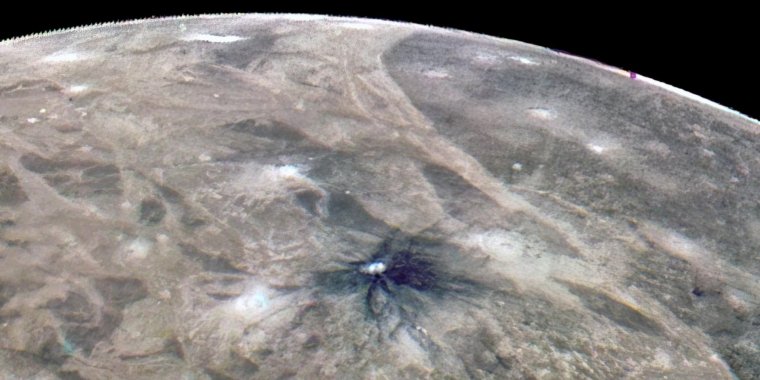| News / Space News |
Salts and Organics Observed on Ganymede’s Surface by NASA’s Juno
NASA’s Juno mission has observed mineral salts and organic compounds on the surface of Jupiter’s moon Ganymede.

This look at the complex surface of Jupiter’s moon Ganymede came from NASA’s Juno mission during a close pass in June 2021. Credit: Image data: NASA/JPL-Caltech/SwRI/MSSSImage processing by Thomas Thomopoulos
Data for this discovery was collected by the Jovian InfraRed Auroral Mapper (JIRAM) spectrometer aboard the spacecraft during a close flyby of the icy moon.
Larger than the planet Mercury, Ganymede is the biggest of Jupiter’s moons and has long been of great interest to scientists due to the vast internal ocean of water hidden beneath its icy crust.
Previous spectroscopic observations by NASA’s Galileo spacecraft and Hubble Space Telescope as well as the European Southern Observatory’s Very Large Telescope hinted at the presence of salts and organics, but the spatial resolution of those observations was too low to make a determination.
On June 7, 2021, Juno flew over Ganymede at a minimum altitude of 650 miles (1,046 kilometers). Shortly after the time of closest approach, the JIRAM instrument acquired infrared images and infrared spectra (essentially the chemical fingerprints of materials, based on how they reflect light) of the moon’s surface.
The JIRAM data of Ganymede obtained during the flyby achieved an unprecedented spatial resolution for infrared spectroscopy – better than 0.62 miles (1 kilometer) per pixel.
With it, Juno scientists were able to detect and analyze the unique spectral features of non-water-ice materials, including hydrated sodium chloride, ammonium chloride, sodium bicarbonate, and possibly aliphatic aldehydes.
“The presence of ammoniated salts suggests that Ganymede may have accumulated materials cold enough to condense ammonia during its formation,” said Federico Tosi, a Juno co-investigator from Italy’s National Institute for Astrophysics in Rome and lead author of the paper.
“The carbonate salts could be remnants of carbon dioxide-rich ices.”
Previous modeling of Ganymede’s magnetic field determined the moon’s equatorial region, up to a latitude of about 40 degrees, is shielded from the energetic electron and heavy ion bombardment created by Jupiter’s hellish magnetic field.
The presence of such particle fluxes is well known to negatively impact salts and organics.
During the June 2021 flyby, JIRAM covered a narrow range of latitudes (10 degrees north to 30 degrees north) and a broader range of longitudes (minus 35 degrees east to 40 degrees east) in the Jupiter-facing hemisphere.
“We found the greatest abundance of salts and organics in the dark and bright terrains at latitudes protected by the magnetic field,” said Scott Bolton, Juno’s principal investigator from the Southwest Research Institute in San Antonio.
“This suggests we are seeing the remnants of a deep ocean brine that reached the surface of this frozen world.”
YOU MAY ALSO LIKE





